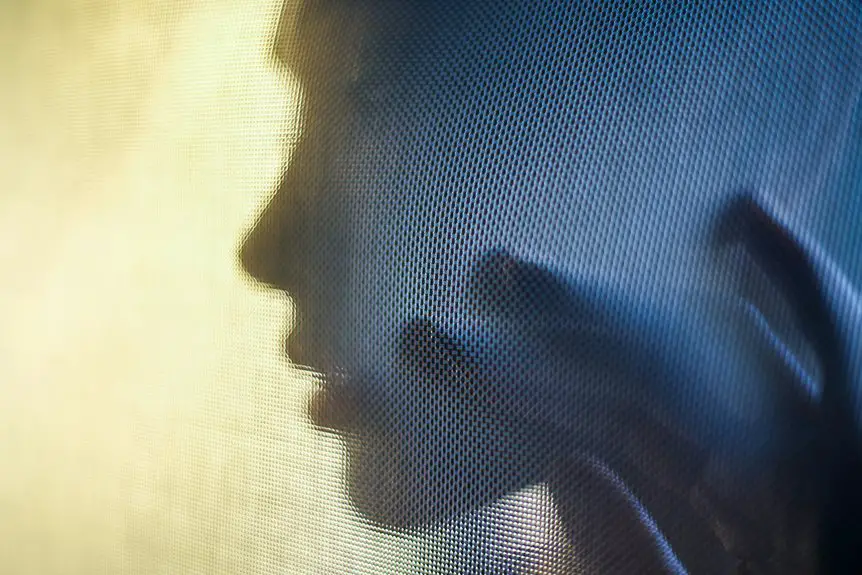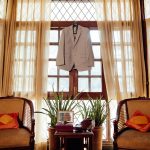To create a stunning DIY projection screen, choose lightweight, translucent scrim fabric that evenly diffuses light for crisp, bright images without glare. Stretch the fabric tightly over a well-measured frame, securing edges with staples or tacks while keeping tension even to avoid wrinkles. Control ambient light and adjust your projector’s contrast and focus for vivid colors and sharp detail. With the right setup and care, you’ll achieve professional-quality visuals easily. Keep exploring to discover tips on frame prep, lighting, and creative enhancements.
Table of Contents
Key Takeaways
- Choose scrim fabric with appropriate weave density and translucency for your projection type (front or rear) to ensure sharp, vibrant images.
- Measure and build a sturdy frame, then stretch the scrim fabric evenly using opposite tension and secure with staples or tacks.
- Use wooden wedges to maintain even fabric tension and apply edge binding or tape to protect and reinforce fabric edges.
- Control ambient light with blackout curtains and indirect lighting to reduce glare and enhance image contrast on your scrim screen.
- Clean the scrim gently with a soft cloth, store rolled in a dry place, and consider creative touches like LED backlighting or custom prints.
What Is Scrim Fabric and Why Choose It for Projection Screens
Scrim fabric is a lightweight, translucent material often used in theater and stage design, but it’s also an excellent choice for projection screens.
When you use scrim fabric, you get a surface that allows light to pass through just enough to create sharp images without glare. It’s flexible and easy to stretch over frames, making it perfect for DIY projects.
Unlike heavier fabrics, scrim is thin and breathable, so you won’t have to worry about wrinkles or sagging. Plus, it’s durable and affordable, so you won’t break the bank while building your screen.
Choosing scrim fabric means you’re opting for a material that balances transparency and image clarity, giving you a professional-looking projection screen without the complexity or cost.
Key Properties of Scrim Fabric That Enhance Visuals
Although it may seem simple, the unique weave and texture of this fabric considerably improve the clarity and brightness of projected images.
When you use scrim fabric, its tight mesh structure diffuses light evenly, reducing hotspots and glare. This means your visuals appear sharp and vibrant, even in ambient light.
The fabric’s translucency also plays a key role—it allows some light to pass through, creating a natural depth and enhancing contrast. Plus, scrim’s matte finish prevents reflections that can wash out colors.
Because it’s lightweight yet strong, you can stretch it taut without wrinkles, maintaining a smooth, flat surface for pristine image reproduction.
These properties work together, giving you a clear, bright, and immersive viewing experience every time.
Selecting the Right Type of Scrim Fabric for Your Screen
When choosing fabric for your projection screen, you’ll want to take into account factors like weave density, translucency, and durability to guarantee the best image quality.
Selecting the right scrim fabric assures your visuals are sharp and vibrant without unwanted glare or shadowing.
Consider these key points:
- Weave Density: A tighter weave offers clearer images but less transparency, ideal for front projection.
- Translucency: More translucent scrims let light pass through, perfect for rear projection setups.
- Durability: Pick a fabric that resists stretching and tearing, maintaining a smooth and flat surface over time.
Measuring and Preparing Your Projection Screen Frame
Choosing the right fabric sets the foundation, but to display your visuals properly, you need a sturdy frame that fits your screen perfectly.
Start by deciding the screen size based on your viewing space. Measure the width and height carefully, allowing extra inches for wrapping the fabric around the frame edges. Use a level and tape measure to guarantee your frame will be square and stable.
Choose materials like PVC pipes, wood, or metal that suit your budget and skills. Cut the frame components precisely according to your measurements. Before assembly, sand any rough edges to prevent fabric damage.
Lay out all parts to confirm accuracy and alignment. Preparing a solid, well-measured frame guarantees your scrim fabric stays taut and your projection looks crisp.
Cutting and Handling Scrim Fabric Safely
Before you start cutting your scrim fabric, make sure you have a clean, flat workspace and the right tools, such as sharp scissors or a rotary cutter.
Handling the fabric carefully prevents fraying and keeps your cuts precise. Lay the fabric out smoothly, avoiding wrinkles or folds that could distort measurements. Use weights or pins to hold it steady.
Handle fabric gently and lay it flat, using weights or pins to keep it steady and prevent fraying.
Follow these steps to cut safely and accurately:
- Measure twice, cut once—mark your cut lines clearly with a fabric-safe pencil.
- Cut slowly along the marked lines to maintain straight edges.
- Store leftover fabric flat or rolled to avoid creases and damage.
Techniques for Stretching Scrim Fabric on the Frame
After cutting your scrim fabric carefully, the next step involves stretching it tightly over the frame to create a smooth, even surface for projection.
Begin by securing one edge of the fabric to the frame using staples or clamps, ensuring it’s aligned properly. Move to the opposite side, pulling the fabric taut before attaching it.
Repeat this process for the remaining edges, working opposite sides to maintain even tension. Use your hands to smooth out any wrinkles as you go, but avoid overstretching.
If needed, insert small wooden wedges between the fabric and the frame to hold tension without damaging the scrim. This method helps maintain a flat surface, essential for clear, vibrant visuals during projection, setting you up for fine-tuning in the next steps.
Tips for Achieving Optimal Tension and Smoothness
To get the best tension and smoothness, start with a sturdy, well-built frame that holds the fabric tight.
Use consistent stretching techniques to avoid wrinkles and sagging as you pull the fabric across the frame.
Finally, secure the edges firmly to maintain an even surface without any puckering.
Proper Frame Construction
Achieving ideal tension and smoothness starts with selecting the right materials and assembling a sturdy frame. Your frame needs to resist warping and hold the scrim fabric taut without sagging.
Focus on durable, straight wood or metal for best results.
Here are three key tips to guide you:
- Choose quality lumber or lightweight metal — hardwood, aluminum, or steel guarantee stability and longevity.
- Use corner braces or metal brackets — reinforce joints to prevent wobbling and maintain perfect angles.
- Measure and cut precisely — even slight inaccuracies can lead to uneven tension and wrinkles.
Stretching Techniques
Although proper frame construction sets the foundation, you’ll need effective stretching techniques to confirm your projection screen stays smooth and taut.
Start by laying your scrim fabric flat and aligning it evenly over the frame. Use gentle, consistent pulls from opposite sides to avoid wrinkles and uneven tension. Work gradually, alternating between edges to maintain balance.
Avoid overstretching, which can warp the frame or distort the fabric. Using clamps or temporary fasteners can help hold the fabric in place while you adjust tension.
Keep an eye on corners to confirm they stay tight without puckering. Taking your time and stretching methodically will give you a flawless surface that enhances image quality and keeps your scrim fabric looking professional.
Securing Fabric Edges
Once you’ve stretched the fabric evenly across the frame, securing the edges becomes key to maintaining that smooth tension.
You want to prevent any slack or wrinkles that can distort your projected image. Here’s how to lock in that perfect pull:
- Use staple guns or upholstery tacks: Attach the fabric to the frame, starting at the center of each side, then work toward the corners, pulling taut as you go.
- Add corner folds neatly: Fold the fabric at each corner like wrapping a present, ensuring no extra bulk or sagging.
- Apply edge binding or tape: Seal the edges to reinforce tension and protect the fabric from fraying over time.
Following these steps guarantees a sleek, flat surface for stunning visuals every time.
Best Projector Settings to Complement Scrim Screens
How can you optimize your projector settings to get the best image quality on a scrim screen?
Start by adjusting the brightness to a moderate level; scrim fabric diffuses light, so too much brightness can wash out the image.
Increase contrast to deepen blacks and enhance color vibrancy, making details pop through the semi-transparent material.
Set the color temperature to a neutral or slightly warmer tone to compensate for the fabric’s subtle texture.
Focus your lens carefully, as scrim screens can reveal slight softness if the projector isn’t perfectly sharp.
Finally, tweak the sharpness setting sparingly—overdoing it creates unwanted noise.
Enhancing Image Quality With Proper Lighting Conditions
To get the best image quality, you’ll want to manage ambient light carefully, keeping it low but not completely dark.
You should also control light reflections that can wash out your screen or cause glare.
These steps will help your DIY projection screen deliver crisp and vibrant visuals every time.
Optimal Ambient Light Levels
Although your DIY projection screen can deliver sharp images, controlling ambient light in your room plays an essential role in preserving picture quality.
Too much ambient light washes out colors and reduces contrast, making your visuals look dull. To achieve ideal ambient light levels, consider these tips:
- Use dimmable lights or lamps to adjust brightness without creating harsh glare on the screen.
- Install blackout curtains or shades to block sunlight during daytime viewing.
- Position your screen away from direct light sources like windows or overhead fixtures.
Controlling Light Reflection
Managing ambient light sets the stage, but controlling how light reflects off your DIY projection screen can make a big difference in image clarity. You want to minimize glare and hotspots by adjusting the angle of the projector and using matte scrim fabric. Position your screen so it doesn’t catch direct light from windows or lamps.
Here’s a quick guide to controlling reflection:
| Factor | Recommendation |
|---|---|
| Screen Material | Use matte or low-gloss scrim |
| Projector Angle | Adjust to avoid direct reflection |
| Room Lighting | Use dimmable or indirect sources |
Maintaining and Cleaning Your Scrim Projection Screen
Since your scrim projection screen plays a key role in delivering clear, vibrant images, you’ll want to keep it clean and well-maintained.
Regular care prevents dust buildup and preserves image quality. Here’s how to maintain your scrim screen effectively:
- Dust Gently – Use a soft brush or microfiber cloth to remove dust. Avoid harsh scrubbing to prevent fabric damage.
- Spot Clean Carefully – For stains, dab with a mild soap solution on a damp cloth. Don’t soak the fabric, and let it air dry completely.
- Store Properly – When not in use, roll the scrim fabric loosely and store it in a dry, cool place to avoid wrinkles and mildew.
Creative Applications and Customizations for Scrim Screens
How can you make your scrim projection screen stand out beyond its basic function? Start by experimenting with different frame shapes and sizes to fit your space creatively.
You can paint the edges or add LED backlighting for a dynamic look that enhances the viewing experience. Consider layering scrim fabric to achieve varied opacity levels, allowing you to switch between front and rear projection easily.
Customizing your screen with removable panels or attaching magnetic strips lets you swap fabrics or clean effortlessly. For an artistic touch, print subtle patterns or logos on the scrim, blending visuals with décor.
These creative tweaks not only personalize your setup but also improve functionality, transforming your scrim screen into a versatile centerpiece for movies, presentations, or immersive events.
Frequently Asked Questions
Can Scrim Fabric Be Used for Outdoor Projection Screens?
Yes, you can use scrim fabric for outdoor projection screens. It’s lightweight, durable, and offers great image clarity. Just make sure to secure it properly against wind and moisture to keep your visuals stunning.
What Tools Are Essential for Building a Scrim Projection Screen?
You’ll need a staple gun, scissors, measuring tape, and a wooden frame. A level helps guarantee straight edges, while clamps hold fabric tight. Don’t forget a drill for assembling the frame securely.
How Does Scrim Fabric Compare Cost-Wise to Traditional Screen Materials?
You’ll find scrim fabric generally costs less than traditional screen materials, making it budget-friendly. It offers great value, especially if you want a large, lightweight screen without breaking the bank or sacrificing visual quality.
Are There Any Safety Concerns With Using Scrim Fabric Indoors?
Better safe than sorry—when using scrim fabric indoors, you’ll want to guarantee it’s flame-retardant and securely hung to avoid fire hazards or falls. Proper ventilation also helps prevent any chemical odors from bothering you.
Can Scrim Fabric Screens Be Rolled up for Storage?
Yes, you can roll up scrim fabric screens for storage. Just make sure to roll them gently to avoid creases or damage. Store in a dry, cool place to keep the fabric in great condition for your next use.
- Mastering the Art of I-Dye for Innova Discs - July 14, 2025
- Understanding the Basics of Fabric Dyeing - July 14, 2025
- A Deep Dive Into Dip Dyeing and Gradient Techniques - July 14, 2025







